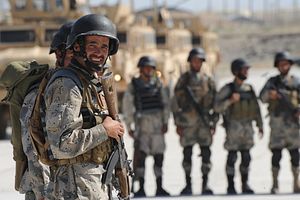Earlier last month, the White House told Congress that it needed to cough up an additional $11.6 billion for the United States’ current campaign against Islamic State (ISIS) militants and the war in Afghanistan. In a statement later that evening, U.S. Defense Secretary Ash Carter emphasized that the money “is vitally important for our national security, and I strongly urge Congress to adopt it.’’ The additional funds would bring the price tag for both wars to a whopping $85.3 billion in 2017.
And so continues Afghanistan’s tumultuous road to peace and stability. Afghanistan’s history is replete with wars and other violent conflicts, including most recently more than three decades of foreign occupation, civil war, and insurgency since 1978. So it comes as no surprise that throughout its long and turbulent history, Afghanistan has looked more like a tribal confederacy than a cohesive nation-state.
The range of tenable outcomes in Afghanistan is becoming limited. The Taliban control more territory now than at any time since 2001, when they were overthrown by the United States. The current Afghan National Unity Government (NUG) only controls two-thirds of the country. Just to put things in perspective, since January 2016 the Taliban have contested five provincial capitals, executed some of the worst terrorist attacks in the capital city of Kabul, and have carried out attacks in all 34 provinces of the country, with an average of 68 attacks a day. The Afghan National Defense and Security Forces (ANDSF) are barely able to defend themselves, which leaves the prospect of defeating the Taliban no longer meaningful. It is highly unlikely that the ANDSF will take the offensive and give the Taliban a coup de grace.
So the Afghan government could either lose the war outright, or could negotiate a compromise settlement with the Taliban. And with each passing day, a majority of Taliban leaders have become disinterested in pursuing peace talks with the Afghan government and understandably so, as the Taliban’s battlefield successes make them less interested in compromise. The Taliban need to be cautious of their arrogant bravado. The international community has spent 15 years and billions of dollars ($783 billion to be exact) in Afghanistan and they would not let all their efforts go in vain.
The ineptitude of the NUG has also compounded problems. The U.S.-brokered 2014 deal between President Ashraf Ghani and Chief Executive Officer Abdullah Abdullah lacked sufficient Afghan ownership. There have been major tensions within the National Unity Government and it has stalled on pledged reforms. The country is beset with acute corruption, warlordism, kleptocracy, and political violence. Although there are Afghan officials and military officers who are committed to bringing about a positive change in their country, their efforts tend to go unnoticed.
To make things worse, the United States and the international community have failed to enforce any kind of conditionality or accountability on the donor aid being pumped into the country. It is extremely important for the Afghan government to realize that the U.S. Congress will not keep on writing multi-billion-dollar checks for Afghanistan for an unlimited time period. Donor fatigue will set in and may push Afghanistan into a fiscal crisis that it may not be able to sustain. With the election of Donald Trump as the next U.S. president, there are already cries to let go of Afghanistan. During his election campaign, Trump’s foreign policy orientation crossed traditional policy boundaries; whether he will make good on such signals is something we all will find out after the president-elect takes office in January next year.
Adding to the already complex situation, according to a recent report in The Guardian, ISIS has now established a stronghold in two eastern Afghan provinces and al-Qaeda operatives are active in seven provinces. Meanwhile, opium production is up by 43 percent and an estimated 1.2 million Afghans are displaced in their own country, provides perfect recruitment fodder for these terrorist organizations. While these problems have not created the most conducive conditions for the peace process to move forward, it also shows the seriousness of the situation and makes the continuation of the peace talks all the more important.
While many analysts are questioning the “end date” in Afghanistan, there are more relevant questions: What condition will Afghanistan be left in? What will be the future of beleaguered Afghanistan, especially with regards to the capacity and capability of the unity government? What possible scenarios are on the horizon for post-2016 and how well is the international community prepared to meet the emerging challenges?
There is a dire need to define the “end state” rather than the “end date” for Afghanistan.
Umar Khan a Researcher at Islamabad Policy Research Institute (IPRI), a think-tank based in Islamabad, Pakistan. He holds a Master’s Degree in International Studies and Diplomacy from the School of Oriental and African Studies (SOAS), University of London.

































